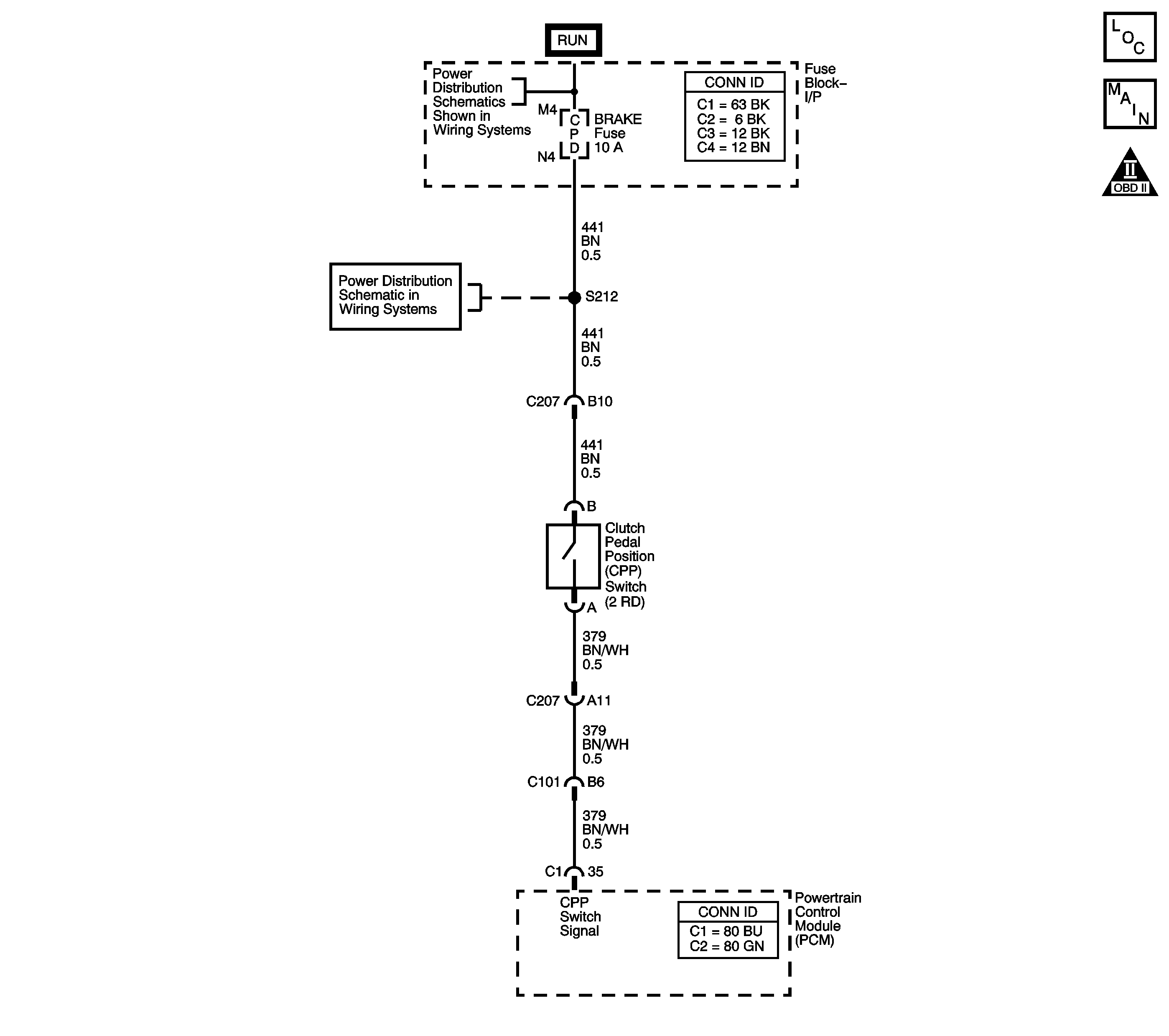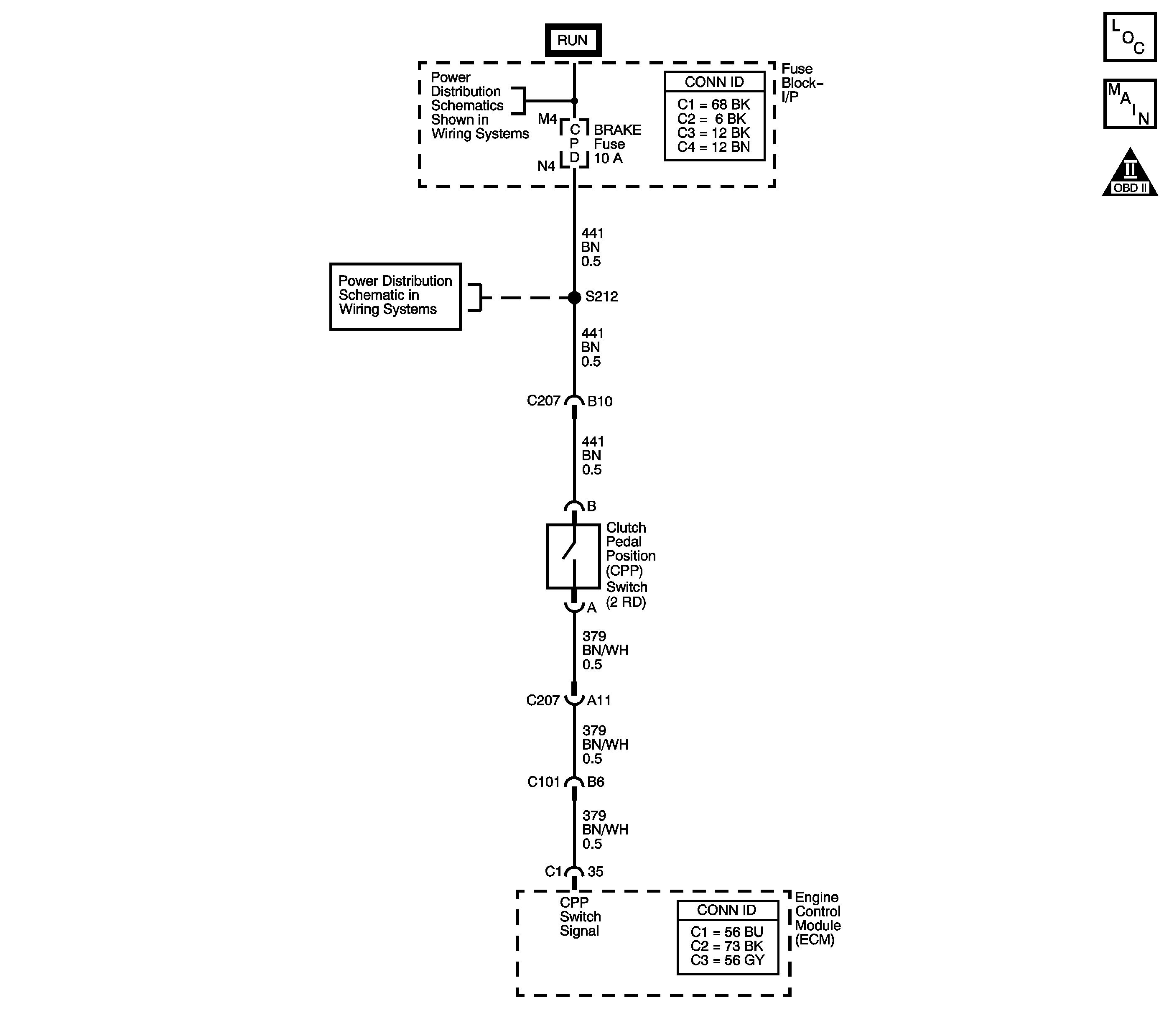DTC P0833 8.1L

Circuit Description
Battery voltage is supplied from the brake fuse to the clutch switch. The clutch switch is a normally-closed switch. When the clutch pedal is released, the clutch pedal position (CPP) switch signal circuit is pulled up to B+. When the clutch pedal is applied, the switch opens and the voltage drops to 0 volts.
When the powertrain control module (PCM) detects a large number of gear changes without detecting a clutch switch transition, DTC P0833 sets. DTC P0833 is a type B DTC.
DTC Descriptor
This diagnostic procedure supports the following DTC:
DTC P0833 Clutch Pedal Switch 2 Circuit
Conditions for Running the DTC
No VSS DTC P0500.
Conditions for Setting the DTC
The PCM detects 7 changes in vehicle speed greater than 38 km/h (24 mph) without the PCM detecting a clutch pedal transition.
Action Taken When the DTC Sets
| • | The PCM illuminates the malfunction indicator lamp (MIL) during the second consecutive trip in which the Conditions for Setting the DTC are met. |
| • | The PCM disables cruise control. |
| • | The PCM disables power take-off. |
| • | The PCM records the operating conditions when the Conditions for Setting the DTC are met. The PCM stores this information as Freeze Frame and Failure Records. |
| • | The PCM stores DTC P0833 in PCM history during the second consecutive trip in which the Conditions for Setting the DTC are met. |
Conditions for Clearing the MIL/DTC
| • | The PCM turns OFF the MIL during the third consecutive trip in which the diagnostic test runs and passes. |
| • | A scan tool can clear the MIL/DTC. |
| • | The PCM clears the DTC from PCM history if the vehicle completes 40 warm-up cycles without an emission-related diagnostic fault occurring. |
| • | The PCM cancels the DTC default actions when the ignition switch is OFF long enough in order to power down the PCM. |
Step | Action | Value(s) | Yes | No |
|---|---|---|---|---|
1 | Did you perform the Diagnostic System Check - Vehicle? | -- | Go to Step 2 | |
2 |
Important: Before clearing the DTCs use the scan tool in order to record the Freeze Frame and Failure Records for reference. The Clear Info function will erase the data. Does the scan tool indicate a change in state when the clutch pedal is either applied or released? | -- | Go to Testing for Intermittent Conditions and Poor Connections | Go to Step 3 |
3 | Inspect the CPP switch. Refer to Clutch Pedal Position Switch Replacement . Did you find and correct a condition? | -- | Go to Step 14 | Go to Step 4 |
4 |
Caution: Refer to SIR Caution in the Preface section. Does the DMM indicate the specified value? | B+ | Go to Step 5 | Go to Step 11 |
5 |
Does the scan tool display that the clutch is released? | -- | Go to Step 8 | Go to Step 6 |
6 |
Did you detect continuity? | -- | Go to Step 7 | Go to Step 10 |
7 | Use the DMM to test for continuity between the CPP switch signal circuit of the CPP switch harness connector and ground. Refer to Testing for Continuity . Did you detect continuity? | -- | Go to Step 10 | Go to Step 9 |
8 |
Did you find and correct the condition? | -- | Go to Step 14 | Go to Step 12 |
9 |
Did you find and correct the condition? | -- | Go to Step 14 | Go to Step 13 |
10 | Repair the open or short to ground in the CPP switch signal circuit. Refer to Wiring Repairs . Is the action complete? | -- | Go to Step 14 | -- |
11 | Repair the open in the CPP switch feed circuit. Refer to Wiring Repairs . Is the action complete? | -- | Go to Step 14 | -- |
12 | Replace the CPP switch. Refer to Clutch Pedal Position Switch Replacement . Is the action complete? | -- | Go to Step 14 | -- |
13 | Replace the PCM. Refer to Control Module References for replacement, setup, and programming. Is the action complete? | -- | Go to Step 14 | -- |
14 |
Has the test run and passed? | -- | Go to Step 15 | Go to Step 2 |
15 | With the scan tool, observe the stored information, capture info and DTC info. Does the scan tool display any DTCs that you have not diagnosed? | -- | System OK |
DTC P0833 6.6L

Circuit Description
Battery voltage is supplied from the brake fuse to the clutch switch. The clutch switch is a normally-closed switch. When the clutch pedal is released, the clutch pedal position (CPP) switch signal circuit is pulled up to B+. When the clutch pedal is applied, the switch opens and the voltage drops to 0 volts.
When the engine control module (ECM) detects a large number of gear changes without detecting a clutch switch transition, DTC P0833 sets. DTC P0833 is a type C DTC.
DTC Descriptor
This diagnostic procedure supports the following DTC:
DTC P0833 Clutch Pedal Switch 2 Circuit
Conditions for Running the DTC
No VSS DTC P0500.
Conditions for Setting the DTC
The ECM detects 7 changes in vehicle speed from 0 km/h (0 mph) to above 38 km/h (24 mph) and then back to 0 km/h (0 mph) without the ECM detecting a clutch pedal transition.
Action Taken When the DTC Sets
| • | The ECM does not illuminate the malfunction indicator lamp (MIL). |
| • | The ECM disables cruise control. |
| • | The ECM disables power take-off. |
| • | The ECM records the operating conditions when the Conditions for Setting the DTC are met. The ECM stores this information as Failure Records. |
| • | The ECM stores DTC P0833 in ECM history. |
Conditions for Clearing the DTC
| • | A scan tool can clear the DTC. |
| • | The ECM clears the DTC from ECM history if the vehicle completes 40 warm-up cycles without a non-emission-related diagnostic fault occurring. |
| • | The ECM cancels the DTC default actions when the ignition switch is OFF long enough in order to power down the ECM. |
Step | Action | Value(s) | Yes | No |
|---|---|---|---|---|
1 | Did you perform the Diagnostic System Check - Vehicle? | -- | Go to Step 2 | |
2 |
Important: Before clearing the DTCs use the scan tool in order to record the Failure Records for reference. The Clear Info function will erase the data. Does the scan tool indicate a change in state when the clutch pedal is either applied or released? | -- | Go to Testing for Intermittent Conditions and Poor Connections | Go to Step 3 |
3 | Inspect the CPP switch. Refer to Clutch Pedal Position Switch Replacement . Did you find and correct a condition? | -- | Go to Step 14 | Go to Step 4 |
4 |
Caution: Refer to SIR Caution in the Preface section. Does the DMM indicate the specified value? | B+ | Go to Step 5 | Go to Step 11 |
5 |
Does the scan tool display that the clutch is released? | -- | Go to Step 8 | Go to Step 6 |
6 |
Did you detect continuity? | -- | Go to Step 7 | Go to Step 10 |
7 | Use the DMM to test for continuity between the CPP switch signal circuit of the CPP switch harness connector and ground. Refer to Testing for Continuity . Did you detect continuity? | -- | Go to Step 10 | Go to Step 9 |
8 |
Did you find and correct the condition? | -- | Go to Step 14 | Go to Step 12 |
9 |
Did you find and correct the condition? | -- | Go to Step 14 | Go to Step 13 |
10 | Repair the open or short to ground in the CPP switch signal circuit. Refer to Wiring Repairs . Is the action complete? | -- | Go to Step 14 | -- |
11 | Repair the open in the CPP switch feed circuit. Refer to Wiring Repairs . Is the action complete? | -- | Go to Step 14 | -- |
12 | Replace the CPP switch. Refer to Clutch Pedal Position Switch Replacement . Is the action complete? | -- | Go to Step 14 | -- |
13 | Replace the ECM. Refer to Control Module References for replacement, setup, and programming. Is the action complete? | -- | Go to Step 14 | -- |
14 |
Has the test run and passed? | -- | Go to Step 15 | Go to Step 2 |
15 | With the scan tool, observe the stored information, capture info and DTC info. Does the scan tool display any DTCs that you have not diagnosed? | -- | System OK |
